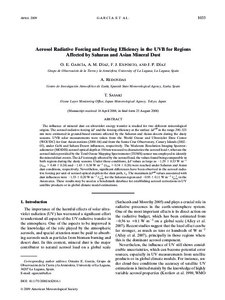Por favor, use este identificador para citar o enlazar este ítem:
http://hdl.handle.net/20.500.11765/2380
Aerosol radiative forcing and forcing efficiency in the UVB for regions affected by Saharan and Asian mineral dust
| Título : | Aerosol radiative forcing and forcing efficiency in the UVB for regions affected by Saharan and Asian mineral dust |
| Autor : | García Rodríguez, Omaira Elena





|
| Palabras clave : | Aerosols; Radiative forcing; Dust storms; Optical properties |
| Fecha de publicación : | 2009 |
| Editor: | American Meteorological Society |
| Citación : | Journal of the Atmospheric Sciences. 2009, 66(4), p. 1033-1040 |
| Versión del editor: | http://dx.doi.org/10.1175/2008JAS2816.1 |
| Resumen : | The influence of mineral dust on ultraviolet energy transfer is studied for two different mineralogical origins. The aerosol radiative forcing ΔF and the forcing efficiency at the surface ΔFeff in the range 290–325 nm were estimated in ground-based stations affected by the Saharan and Asian deserts during the dusty seasons. UVB solar measurements were taken from the World Ozone and Ultraviolet Data Center (WOUDC) for four Asian stations (2000–04) and from the Santa Cruz Observatory, Canary Islands (2002–03), under Gobi and Sahara Desert influences, respectively. The Moderate Resolution Imaging Spectroradiometer (MODIS) aerosol optical depth at 550 nm was used to characterize the aerosol load τ, whereas the aerosol index provided by the Total Ozone Mapping Spectrometer (TOMS) sensor was employed to identify the mineral dust events. The ΔF is strongly affected by the aerosol load, the values found being comparable in both regions during the dusty seasons. Under those conditions, ΔF values as large as −1.29 ± 0.53 W m−2 (τ550 = 0.48 ± 0.24) and −1.43 ± 0.38 W m−2 (τ550 = 0.54 ± 0.26) were reached under Saharan and Asian dust conditions, respectively. Nevertheless, significant differences have been observed in the aerosol radiative forcing per unit of aerosol optical depth in the slant path, τS. The maximum ΔFeff values associated with dust influences were −1.55 ± 0.20 W m−2 τS550−1 for the Saharan region and −0.95 ± 0.11 W m−2 τS550−1 in the Asian area. These results may be used as a benchmark database for establishing aerosol corrections in UV satellite products or in global climate model estimations. |
| Patrocinador: | We acknowledge the MCYT (Ministry of Science and Technology, Spain) and F.E.D.E.R. foundations (E.U.) for their economic support of projects CGL2004-05984-C07-05, CGL2005-03428-C04-02, CGL2007-66477-C02-02/CLI, CGL2008-04740/CLI and PI042005/033. |
| URI : | http://hdl.handle.net/20.500.11765/2380 |
| ISSN : | 0022-4928 1520-0469 |
| Colecciones: | Artículos científicos 2005-2009 |
Ficheros en este ítem:
| Fichero | Descripción | Tamaño | Formato | ||
|---|---|---|---|---|---|
| 2008JAS2816.pdf | 1,18 MB | Adobe PDF |  Visualizar/Abrir |
Los ítems de Arcimis están protegidos por una Licencia Creative Commons, salvo que se indique lo contrario.





